Creating Artist Trading Cards
Today you’re going to learn how to make Artist Trading Cards, or ATCs for short. It was written with those of you in mind who are not familiar with this art form and will be very basic. I will be doing additional posts in the future showing various techniques and methods for making cards.
This tutorial will walk you through creating your very first card. You’ll learn everything from making your own blank trading cards, to how to make your first trade.
Making Artist Trading Cards is a great way to work on developing your art skills. Because they are so small in size, making one is typically less time consuming than full size works of art. Of course, this can also create a challenge.
But once you get used to working in this miniature art form, you’ll never look back. Let this serve as a warning. Making, and trading, artist trading cards is an addictive hobby.
Not only is making and trading ATCs highly addictive, but it actually makes getting the mail exciting! Can you imagine looking forward to getting the mail?
What Are Artist Trading Cards?
Artist trading cards are miniature works of art that are traded around the world. Artists, of all skill levels, make and trade their artwork with other artists. These trades can be done in person or over the internet using the mailing system.
Artist trading cards can be created by brand new artists, or professional artists. They can be created using any medium, or can be mixed media.
These cards are then traded with other artists. Amateur artists can trade with more advanced artists. I’ve even traded with professional illustrators. You never know who will want to trade with you.
Artist trading cards are collected and admired for years.
ATCs are not sold for monetary gain. ACEOs, on the other hand, are sold. These are usually professional quality artwork, but in miniature form.
Artist trading cards are an amazing way to practice drawing and art techniques. They are pretty quick to make, compared to larger works. And you get to trade them for someone else’s artwork.
History of Artist Trading Cards
Artist Trading Cards (ATCs) are miniature works of art that measure 2.5 x 3.5 inches. They are the same size as a football or Pokemon card. ATCs are part of the mail art movement that originated in 1997 by the Swiss artist M. Vanci Stirnemann.
Stirnemann made 1200 cards and ran an exhibition at his art gallery and bookshop. At the end of the exhibition he held a trading session. This artist trading card event was open to all people and all artistic styles.
These trading sessions were ongoing and held in person where trades were done face to face.
This idea was soon adopted by other artists, and quickly spread to a worldwide art form. With the use of the Internet, this remains a very popular way to trade art with others from around the world.
Face to face trading sessions still exist today, but is much more commonly found online. Often, these in person sessions are in the form of workshops where cards can be created during the workshop. These cards are then traded to other attendees of that workshop.
Artist Trading Card Rules
When it comes to making and trading artist trading cards, there are very few rules that have to be followed. However, the ones that do exist MUST be followed. The artist trading card rules are as follows.
- Size = 2.5 x 3.5 inches (64 mm × 89 mm)
- ATCs are traded not sold
- Signed and dated on the back
- Neatness counts
- Do NOT trade other artists cards
Groups and individuals could have their own set of rules. These rules could be specific to that one trade or could be a general rule. Know the rules before committing to a trade.
Artist Trading Card Etiquette
There are some things that I’ve seen come up repeatedly in online artist trading card groups, that have caused some issues with new artists trying to participate in trades. I’ll list some of these things here.
- If the artwork you’re trading is made by a child, state that up front when posting the pictures. There are many people who enjoy trading with young artists. It’s a courtesy to let them know the age of the child who made the cards beforehand.
- Don’t attempt to trade cards that look like there was little to no effort involved. This doesn’t mean you have to have professional looking artwork. But I’ve seen many ATCs where someone put a sticker on a card and drew an outline around the outside of it, and called it an original work of art.
- Hand drawn and hand painted cards seem to trade a lot quicker than mixed media cards. That doesn’t mean there aren’t groups where mixed media are more popular. I’m just pointing out an observation I’ve made.
- It is highly frowned upon to trade cards that are not your own, or to give them away. Cards are meant to be collected, not given away when you get bored with them. Or especially, if you don’t enjoy them.
Artist Trading Card Size
Probably the most important rule with artist trading cards is the size, and shape of the cards. The overall size of the trading card needs to be 2.5 inches by 3.5 inches. The orientation of the card can go either way.

And they should be thin enough to fit into the clear plastic sleeves used for baseball card or other collectible cards.
If you want to add embellishments to your cards, or alter the overall size and shape of the card, it needs to be able to fit into those sleeves.
For example, I love using a paper punch to round the corners of my cards. I like the way it looks compared to the square corners. The cards will first be cut into 2.5 x 3.5 inch cards, then the punch is used to round off the corners. You can see examples of both in the above picture.
* Some of the links in this post may be affiliate links. This means I receive small commissions for purchases made through these links at no extra cost to you.
Artist Trading Card Supplies
- Cardstock (or paper and something sturdy to mount it to)
- Markers, Colored Pencils
- Outliner Pen
- Cutting Board or Paper Trimmer
- Clear Plastic Sleeves
- Tea Tin (for storage – love these things!)
- Glue Stick
- Corner Punch
FREE Artist Trading Card Guide
How to Make Blank Artist Trading Cards
The first thing you need to do is make some blank trading cards. Or you can buy ready to use artist trading card blanks online already cut to size. But it’s much cheaper to make your own, and really easy to do.
You want your cards to be sturdy. I find white card stock to be an excellent way to make my blank cards. You don’t want your cards to be thin and flimsy, so never use regular weight paper without mounting it to something thicker.
If you’re going to use watercolor paints for your cards, you’ll want to use a paper that can hold up to the water. Standard watercolor paper can be cut down to the size of an artist trading card.
Cards should be cut exactly 2.5 x 3.5 inches and as straight as possible. When making my cards I use a cutting board or paper trimmer to keep them nice and straight. There can be writing on the back of your cards, but the drawing surface should look nice. Unless, of course, it’s part of the overall design and style of the card.
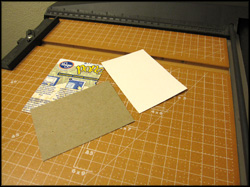
Patterned Backgrounds for Artist Trading Cards
There are many sources of interesting backgrounds that could be used. I have often used scrapbook paper as a background. If you are going to use something like this, mount the paper to either some card stock or even empty food boxes can be cut up and used to add support. No one will see the box anyway as it will be covered or will be on the back of the card.
Just be on the look out for cool designs you could use. Things like tissue boxes, security envelopes, or pages from books can make really cool starters for ATCs. The only limit is your imagination. I have an entire tea tin filled with different backgrounds I can choose from.
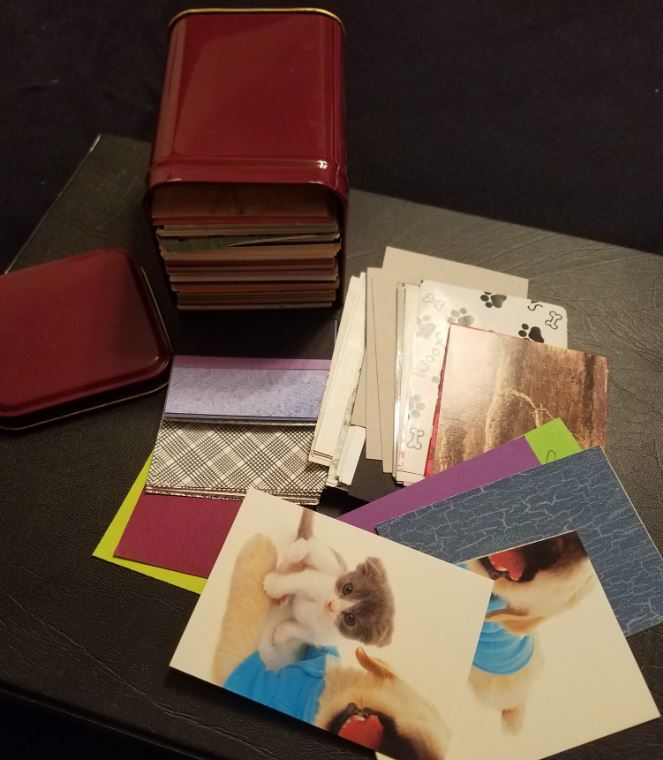
How to Make Artist Trading Cards
Actually making the card is where the real fun begins. The card I made for this tutorial was hand drawn on regular drawing paper. Shown below is the beginning stage of the card. After the card is completed, it will need to mounted to stiffer paper for support.
Mounting the drawing to stiffer paper should be done after the drawing is completed for a couple of reasons. The first reason is because it feels more natural to draw on the thinner paper. The second reason is that sometimes if you mount it first, the paper can have soft spots from the adhesive and it makes it more difficult to draw on. And sometimes will even damage the paper, ruining your artwork altogether.

After your drawing is complete, use a glue stick to mount your card to some heavier weight paper. For this card I used some scrap material I had laying around that is about as thick as cardstock.
After applying the glue, place the card under a heavy stack of books until it is dry. It is important to make sure your two pieces of paper are lined up evenly. One thing I learned throughout my many years of trading cards is that neatness is a huge deal. Here is what the finished card looks like after adding some color.
If you are interested in learning how to do this optical art drawing, you can check out How to Draw an Op Art Bullseye from an earlier art tutorial.
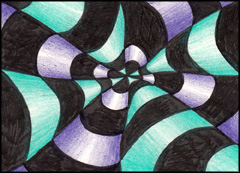
What Goes On the Back of Artist Trading Cards
The final step in creating your card is to sign and date the back. This is a very important step. You can also add a title to your card and some personal contact information for future trades.
Some artists include e-mail, website, Facebook information, etc. You can print out labels to stick on the back of your cards or you can simply hand write the information on the back.
If you’ve made a series of drawings, the number from that series should be included as well.

Artist Trading Card Ideas
Now comes the hard part, deciding what kind of card you want to make. You could do a drawing or a painting. You could make a mixed media card. The possibilities are endless and entirely up to you. Check out these ATC Themes to Spark Your Creativity.
Unless you are doing a themed swap. Then there will be some guidelines you will need to follow. Themed swaps could be a subject matter or it could be a style. The theme could be horror, Christmas, cartoons, hand drawn, birds, etc. Just about anything really.
Looking at group swaps can be a great way to get ideas for what you should draw. If you join atcsforall, they have an entire section for themed swaps. Even if I don’t have time to commit to the trades, I’ll go there from time to time just to look for ideas.
Below are some artist trading card ideas from themed swaps I’ve participated in.
- Monster Girls Artist Trading Cards
- Frida Kahlo Theme ATC Swap
- Robot Drawings Group Artist Trading Card Swap
- Watercolor Doodle Birds ATCs
ATC Examples with Drawing Tutorials
The following artist trading card examples are for drawing tutorials available on this site. Each one has a full step by step list of instructions and were done on ATCs.
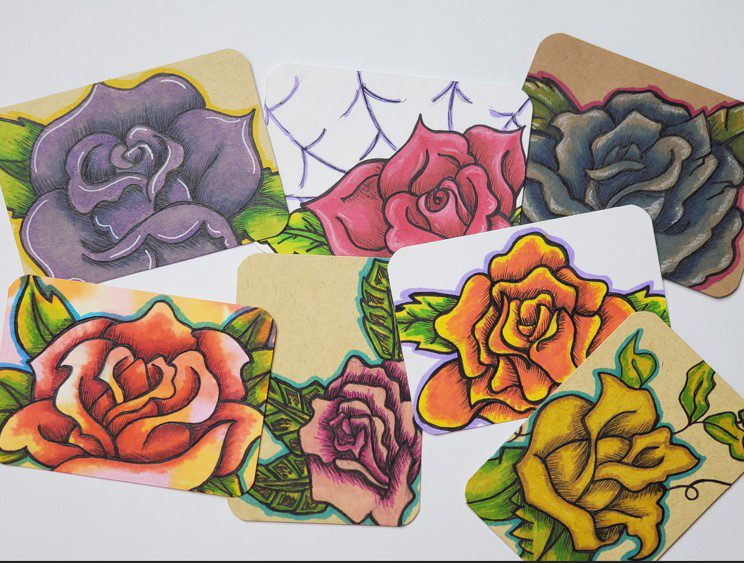

3D Hands Optical Art Art Tutorial
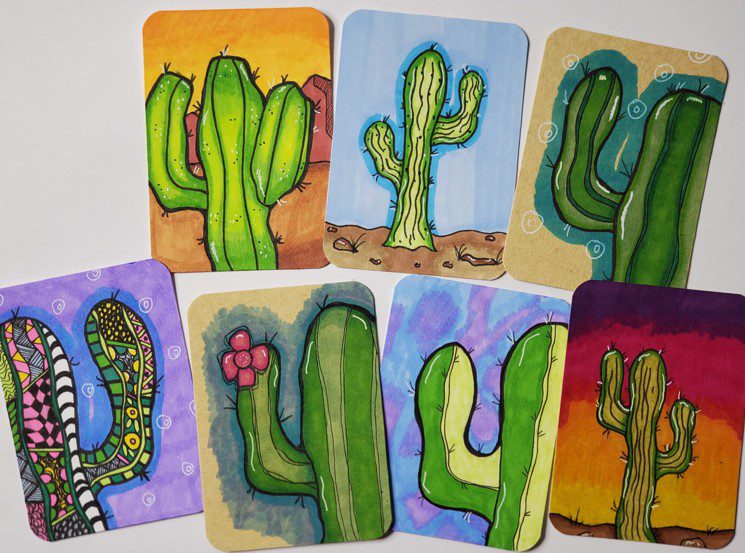
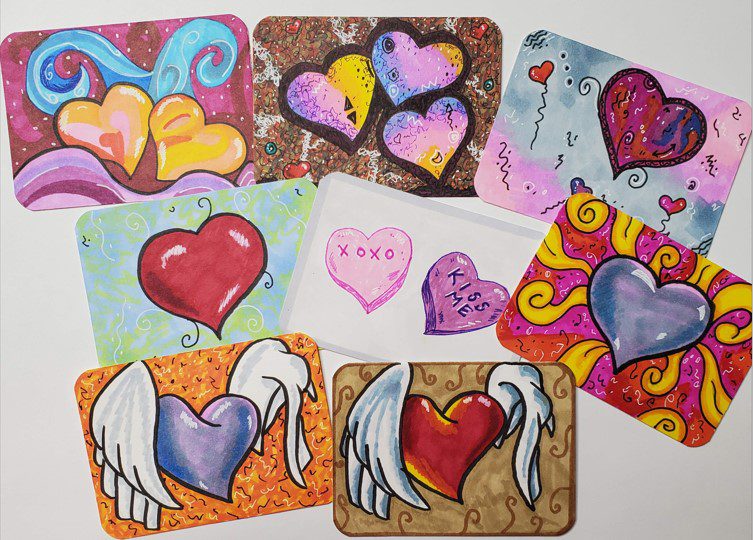
How to Store Artist Trading Cards
You will need to store your cards in a safe place after they are completed. I bought some clear plastic sleeves to keep my cards in. They are inexpensive and the box comes with 200 sleeves.
They are found by the trading cards at Target, Walmart, or other stores that sell trading cards.
I then place my card in a metal tin until it gets shipped out to its new owner. This makes it easy to locate the cards that are being traded, and it keeps the cards safe from being accidentally damaged.
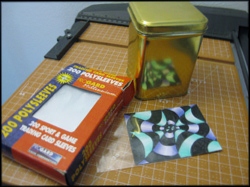
Another option is to store them in binders with pockets to hold artist trading cards. This is typically how cards you have received from other artists will be stored. Either option is fine, just be sure to keep both your cards, and the cards you get in the mail safe.
How to Trade Artist Trading Cards
Now you need to find someone who wants to make a trade with you. There are many sites out there for trading artist trading cards. Typically, you will post your cards in a gallery and state that it is available for trade. It’s usually best to have a variety of cards available for trade.
Unless time is not an issue for you, then making them on the fly might not be a concern for you.
I have several finished Artist Trading Cards available for trade at any given time. Be sure to keep them protected from getting damaged until they find new homes. Having one of your beautiful mini works of art to get ruined is the last thing you want.
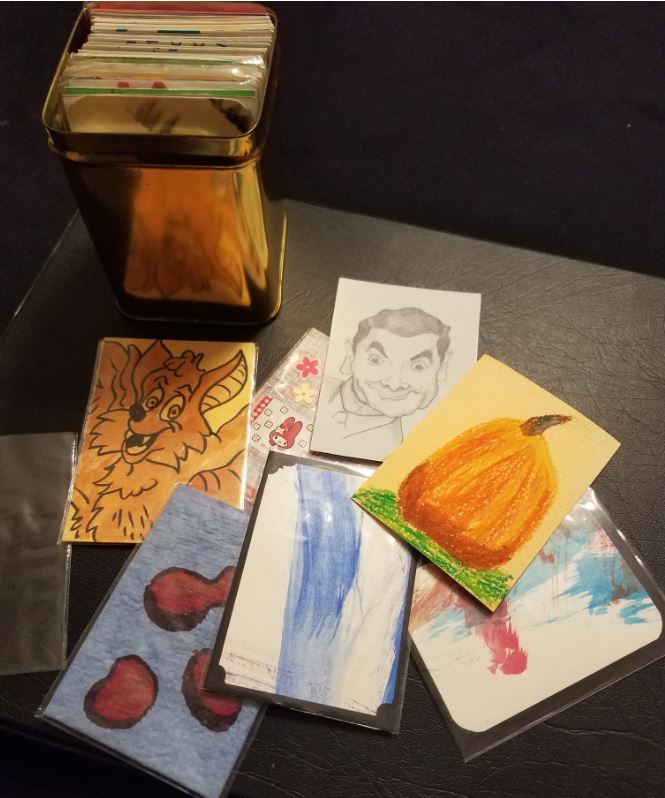
Here are a couple of sites where you can get involved in trading ATCs:
ATCsforall – This in a forum that is still pretty active.
ATC Artist Trading Cards Facebook Group – Active group with friendly people and a good variety of artist style from group members.
After you start getting involved in the artist trading card community you’ll discover many other groups that are out there as well. Find one that feels comfortable for you.
Types of Artist Trading Card Trades
When you get to the point where you start making trades, there are many different types of trades you can make. The type of trade you decide to do is up to you, and depends on what’s available. And who’s willing to trade with you.
Personal Trades
These are the most common. They are usually of equal quantities from both people making the trade. These numbers will sometimes be written as 1:1 or 3:3. This means you send 1 card, and you receive 1 card (1:1). Or, 3 cards for 3 cards (3:3).
You may get asked to do an uneven trade with someone where they give you less cards than what they want you to send to them. I typically won’t do this type of trade. This really isn’t what the tradition of trading is about.
Blind Trade
This means you don’t know what piece of artwork you’re going to receive, and they don’t know what you are going to be sending to them. Be sure to send quality work if you’re doing a blind trade. Don’t use this as a way to get rid of your cards you don’t want anymore.
Themed Group Swaps
These types of swaps are a bit more complicated, and take more time. There will be a theme, and some guidelines set when the swap is set up. All participants make the specified number of cards. Usually 6 or 7 cards will be required.
All cards are sent to the person who is leading the group swap. There will be a deadline set for when you need to ship the cards out in the mail.
The swap leader then mixes up all of the cards and sends them out to each person you sent cards in. You’ll receive several cards, each from a different artist. But of the same theme that was set for the swap.
Often, you will need to send in stamps and self addressed envelopes with these swaps. And sometimes an extra card for the leader of the group swap. Even if the extra card is not required, I always send an extra. Running a group swap is a lot of work.
P.I.F. Trades
Pay It Forward trades are quite interesting. However I’ve never participated in one. These are usually started in their own threads of posts. The way it works is that someone requests a card to be drawn for them. Someone responds by saying they will draw them the card they asked for.
The person who responded then requests a card to be made for them. Someone else comes along later and commits to making that card, and requests their card.
This continues for all of eternity. The person you send your artwork to isn’t who you receive artwork from. And is basically a form of blind trade because you never know what your card looks like until you get it in the mail.
Regardless of which type of trade you’re participating in, be sure to ship your cards as soon as you can. If there is a reason for delay, let the person you’re trading with know.
How to Make Artist Trading Cards (ATCs) | Art Tutorial
I hope you enjoyed this tutorial on how to make artist trading cards. I’d love to see what you come up with. Learning to make creative works of art takes practice. But the good news is that it’s a skill anyone can master.
Never feel like you’re not good enough. Enjoy the creative process and have fun. We have over one hundred art tutorials that show step by step how to draw on artist trading cards. Check them out and get creative!
Grab your FREE ATC Guide and start making more art in less time!



I Love the artist trading cards
These are so much fun to make and they are a great way to practice your artwork because they are small and take less time.
I love the act idea kb
You should give them a try